This article needs additional citations for verification .(June 2020) |

The uniforms of the Sri Lanka Army currently exist in several categories ranging from ceremonial uniforms to combat dress (with full dress uniform). [1]
This article needs additional citations for verification .(June 2020) |

The uniforms of the Sri Lanka Army currently exist in several categories ranging from ceremonial uniforms to combat dress (with full dress uniform). [1]
Uniforms in the Sri Lanka Army originated from those of the British Army and the Ceylon Defence Force, which was instrumental in its formation and today share many similarities with the uniforms of the British and Commonwealth armies. Based on British Army traditions uniforms are differentiated according to the regiment (or corps) to which an officer or soldier belongs. There are several significant uniform differences between infantry and cavalry regiments; furthermore, several features of cavalry uniform were (and are) extended to those corps and regiments deemed for historical reasons to have 'mounted status' in the British Army.
Full dress is the oldest form of uniform and presents the most differentiation between units; although there is then a 'steady thinning out of regimental features', through ceremonial dress, service dress, barrack dress and combat dress, a level of regimental distinction runs throughout. Unlike in the British Army where senior officers, of full colonel rank and above, do not wear regimental uniform (except when serving in the honorary position of a Colonel of the Regiment) and use 'staff uniform'; senior officers of the Sri Lankan Army retain regimental features while incorporating elements of the British staff uniform (which includes a coloured cap band and matching gorget patches in several orders of dress) with a few local variations. These include gorget patches with stars denoting rank in some uniforms, the use of the Kastane by general officers and President's ADCs and batons.
The Sri Lanka Army currently numbers the various uniforms which may be worn. The following table summarises the numbering:

The Ceremonial uniform (No. 1), sometimes referred to as "blues", is a universal ceremonial uniform which is almost consistent throughout the Sri Lankan Army. No. 1 Dress is only worn on ceremonial occasions, service weddings by only officers, the Regimental Sergeant Major Army Headquarters, Academy Sergeant Major of Sri Lanka Military Academy, Regimental Sergeant Majors of Regimental Headquarters, Colour Units, and members of Artillery Saluting Battery. It is identical to the blue patrol uniform of the British Army and was formally designated as No. 2 Dress uniform. In the late 1990s it formally made the No. 1 Dress uniform having been the de facto Dress uniform for many years. Therefore, some regiments still refer to it as No. 2 uniform. In rifle regiments the uniform is in dark green. Medals are worn and swords carried if ordered. No 1 is dressed for corpses of officers. [1]
The No. 1A scarlet uniform is worn by both male and female other ranks of the Sri Lanka Corps of Military Police on ceremonial duty and vigil duties, with the No.1A Presidential Scarlet won mounting guard for the President as part of the President’s Ceremonial Guard. It is similar in nature to the full dress uniforms worn by the British Army and the Indian Army. [1]
The ceremonial uniform of the Serjeant-at-arms of the Sri Lankan Parliament would be similar to a No. 1 Blue Dress uniform of a major general with varied gorget patchs and epaulette similar to a flag officer of the Sri Lanka Navy.

The mess dress uniform, includes a waist-length short jacket, with which men wear trousers, overalls or a kilt; and for women a long skirt. Known as No. 2 and No. 2A (without jacket), generally white jacket used by junior officers and warrant officers and a jacket of the regimental color worn by senior officers frequently includes elaborate braiding on the waistcoats. Female NCOs would wear sarees of a designated design. [1]

The Service Dress uniform, is worn by senior officers of and above the rank of Colonel and their ADCs for less formal occasions and its alternative in winter. Formally approved for wear by all officers, it was rarely worn by most junior officers other than when serving as ADCs. It is based on the warm weather service dress uniform of the British Army. Medals are worn and swords carried if ordered. Traditionally known as the No. 4A it as now been adopted as the No. 2 and No. 3 by certain regiments. [1]
The Review Order uniform is worn by officers and other ranks on ceremonial parades, guards of honour, courts martial or whenever ordered. It is won for state and service funerals. Its alternative No 4A is won as a winter uniform by officers below the rank of Colonel and other ranks. No 4 is worn by other ranks for weddings and is dressed for corpses of other ranks. [1]

The General Purpose Working Dress is worn by officers and other ranks on regimental duties, non-ceremonial parades, for office work, for field work and ordered. [1]


Camofluge uniform also known as no. 7 dress. Since 1990's the U.S. Woodland camofluge pattern has been used first by the Commando Regiment and thereafter by other regiment of the army, becoming the standard pattern of the army from 2010. All ranks of the army can wear this uniform when attending field training and field exercises. In September 2020, the army introduced a new four-coloured digital camouflage uniform to Commando and Special Forces personal. [2]
Cadets attached to the Sri Lanka Military Academy have uniforms that are similar to the standard uniforms.

The No. 1 Ceremonial White dress uniform, was the most formal uniform in Sri Lankan Army. No. 1 was a full white uniform while No. 1A was a white tunic and dark blue trousers similar to the British Army Warm weather ceremonial uniform. No. 1 was reserved to be used by Army officers appointed and serving as Aide-de-camp (ADC) to the President of Sri Lanka at ceremonies. A tradition that dates back to the time when army officers were appointed as Aide-de-camp to the Governor of Ceylon. No. 1A was used during day. It was worn by the Commandant of the Sri Lanka Military Academy at passing out parades in the 1980s and 1990s. The uniform has since been discontinued and army officers assigned as ADC to the President wear the ceremonial blue uniform for all formal functions while the Service Dress uniform is used by other officers for day time functions. [3]
The No. 2 Service dress, similar to the British Army Service Dress was used by the Ceylon Army till the 1970s. The current No. 3 Service Dress worn by offices of and above the rank of Colonel and their ADCs is of a similar design in a lighter shade of Khaki.
British Army style Khaki drill uniforms were used by the Ceylon Army from its formation into the 1970s. Khaki has since been replaced with olive green, with the exception of peaked caps that remain khaki in most regiments. These included shorts.

A military uniform is a standardised dress worn by members of the armed forces and paramilitaries of various nations.

Mess dress uniform is the most formal type of evening-wear uniform used by military personnel, police personnel, and other uniformed services members. It frequently consists of a mess jacket, trousers, white dress shirt and a black bow tie, along with orders and medals insignia. Design may depend on regiment or service branch, e.g. army, navy, air force, marines, etc. In modern Western dress codes, mess dress uniform is the supplementary alternative equivalent to the civilian black tie for evening wear. Mess dress uniforms are typically less formal than full dress uniform, but more formal than service dress uniform.
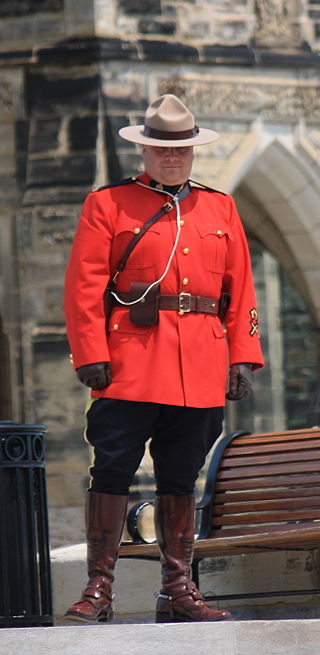
The Red Serge refers to the jacket of the dress uniform of the Royal Canadian Mounted Police. It consists of a scarlet British-style military pattern tunic, complete with a high-neck collar and blue breeches with yellow stripe identifying a cavalry history.

The peaked cap, peaked hat, service cap, barracks cover or combination cap is a form of headgear worn by the armed forces of many nations, as well as many uniformed civilian organisations such as law enforcement agencies and fire departments. It derives its name from its short visor, or peak, which was historically made of polished leather but increasingly is made of a cheaper synthetic substitute.
Colonel is a Canadian Forces rank used by commissioned officers who wear army, air force or special operations uniform. Captain(N) is the equivalent rank for officers who wear navy uniform. A colonel is senior to the army and air force rank of lieutenant-colonel or the naval rank of commander, and junior to the army and air force rank of brigadier-general or the naval rank of commodore.
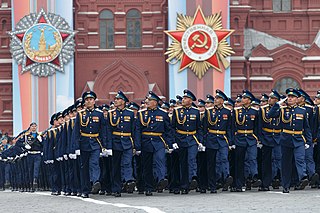
Full dress uniform, also known as a ceremonial dress uniform or parade dress uniform, is the most formal type of uniforms used by military, police, fire and other public uniformed services for official parades, ceremonies, and receptions, including private ones such as marriages and funerals. Full dress uniforms typically include full-size orders and medals insignia. Styles tend to trace back to uniforms used during the 19th century, although the 20th century saw the adoption of mess dress-styled full-dress uniforms. Designs may depend on regiment or service branch. In Western dress codes, full dress uniform is a permitted supplementary alternative equivalent to the civilian white tie for evening wear or morning dress for day wear – sometimes collectively called full dress – although military uniforms are the same for day and evening wear. As such, full dress uniform is the most formal uniform, followed by the mess dress uniform.
The uniforms of the Canadian Armed Forces are the official dress worn by members of Canada's military while on duty.
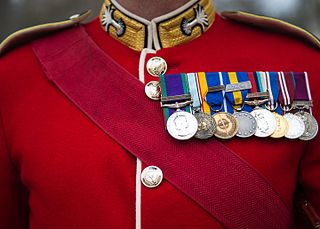
Red coat, also referred to as redcoat or scarlet tunic, is a military garment formerly much used by British infantry servicemen, so customarily that the term became a common synecdoche for the servicemen themselves.
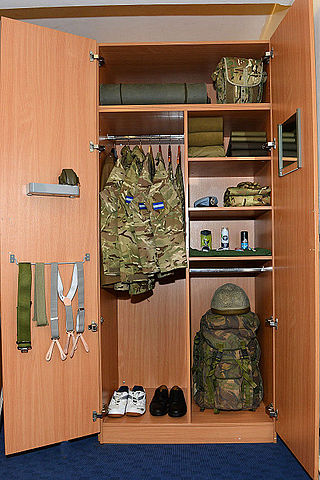
The uniforms of the British Army currently exist in twelve categories ranging from ceremonial uniforms to combat dress. Uniforms in the British Army are specific to the regiment to which a soldier belongs. Full dress presents the most differentiation between units, and there are fewer regimental distinctions between ceremonial dress, service dress, barrack dress and combat dress, though a level of regimental distinction runs throughout.

Service dress uniform is the informal type of uniform used by military, police, fire and other public uniformed services for everyday office, barracks and non-field duty purposes and sometimes for ceremonial occasions. It frequently consists of a jacket, trousers, dress shirt, and neck tie, along with orders, medals, and insignia. Design may depend on regiment or service branch, e.g. army, navy, air force, marines, etc. In Western dress codes, a service dress uniform is a permitted supplementary alternative equivalent to the civilian suit - sometimes collectively called undress or "dress clothes". As such, a service dress uniform is considered less formal than both full dress and mess dress uniforms, but more formal than combat uniforms.

Gorget patches are an insignia in the form of paired patches of cloth or metal on the collar of a uniform (gorget), used in the military and civil service in some countries. Collar tabs sign the military rank, the rank of civil service, the military unit, the office (department) or the branch of the armed forces and the arm of service.

Service Dress is the style of khaki service dress uniform introduced by the British Army for use in the field from the early 1900s, following the experiences of a number of imperial wars and conflicts, including the Second Boer War. This variant of uniform continues to be worn today, although only in a formal role, as No. 2 Pattern dress.
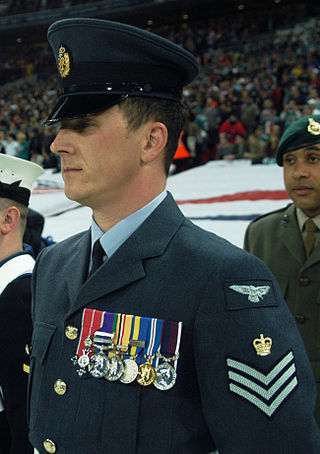
The Royal Air Force uniform is the standardised military dress worn by members of the Royal Air Force. The predominant colours of Royal Air Force uniforms are blue-grey and Wedgwood blue. Many Commonwealth air forces' uniforms are also based on the RAF pattern, but with nationality shoulder flashes. The Royal Air Force Air Cadets wear similar uniforms.
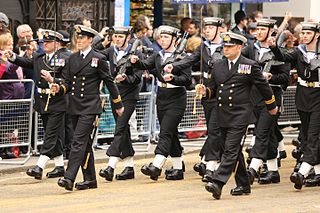
The uniforms of the Royal Navy have evolved gradually since the first uniform regulations for officers were issued in 1748. The predominant colours of Royal Navy uniforms are navy blue and white. Since reforms in 1997 male and female ratings have worn the same ceremonial uniform.

The Sri Lanka Army Medical Corps (SLAMC) (Sinhala: ශ්රී ලංකා යුද හමුදා වෛද්ය බලකාය Shri Lanka Yuddha Hamuda Vayidya Balakaya) is a specialist corps in the Sri Lanka Army which specializes in military medicine and provides medical services to all army personnel and their families in war and in peace. It is made up of 4 regular units and one volunteer unit. Headquartered in Colombo, formally at army headquarters. The corps Cap badge depicting the Rod of Asclepius. General officers and senior officers of the SLMC wear gorget patches of maroon rather than of scarlet worn by other officers of similar rank.
The uniforms of the United States Army distinguish soldiers from other service members. U.S. Army uniform designs have historically been influenced by British and French military traditions, as well as contemporary U.S. civilian fashion trends. The two primary uniforms of the modern U.S. Army are the Army Combat Uniform, used in operational environments, and the Army Green Service Uniform, worn during everyday professional wear and during formal and ceremonial occasions that do not warrant the wear of the more formal blue service uniform.

The Royal Marines uniform is the standardised military dress worn by members of the Royal Marines.
The uniforms of the Australian Army have changed significantly over the past century, although the accoutrements worn over this period have remained relatively similar. The forces of the Australian colonies and the early forces of the Commonwealth post-Federation in 1901 closely followed the uniforms of the British Army. Since then it has continued to be influenced by British but also US styles, as well as including some distinctly Australian designs, reflecting local conditions and trends.

The extensive system of uniforms of the Russian Armed Forces was inherited from the Soviet Armed Forces and modified across the years.

Colonel (Col) is a senior officer rank in the Sri Lanka Army that is a superior rank to lieutenant colonel and subordinate to Brigadier. The rank has a NATO rank code of OF-5, equivalent to captain in the Sri Lanka Navy and group captain in the Sri Lanka Air Force. It was the highest rank in the Ceylon Defence Force.